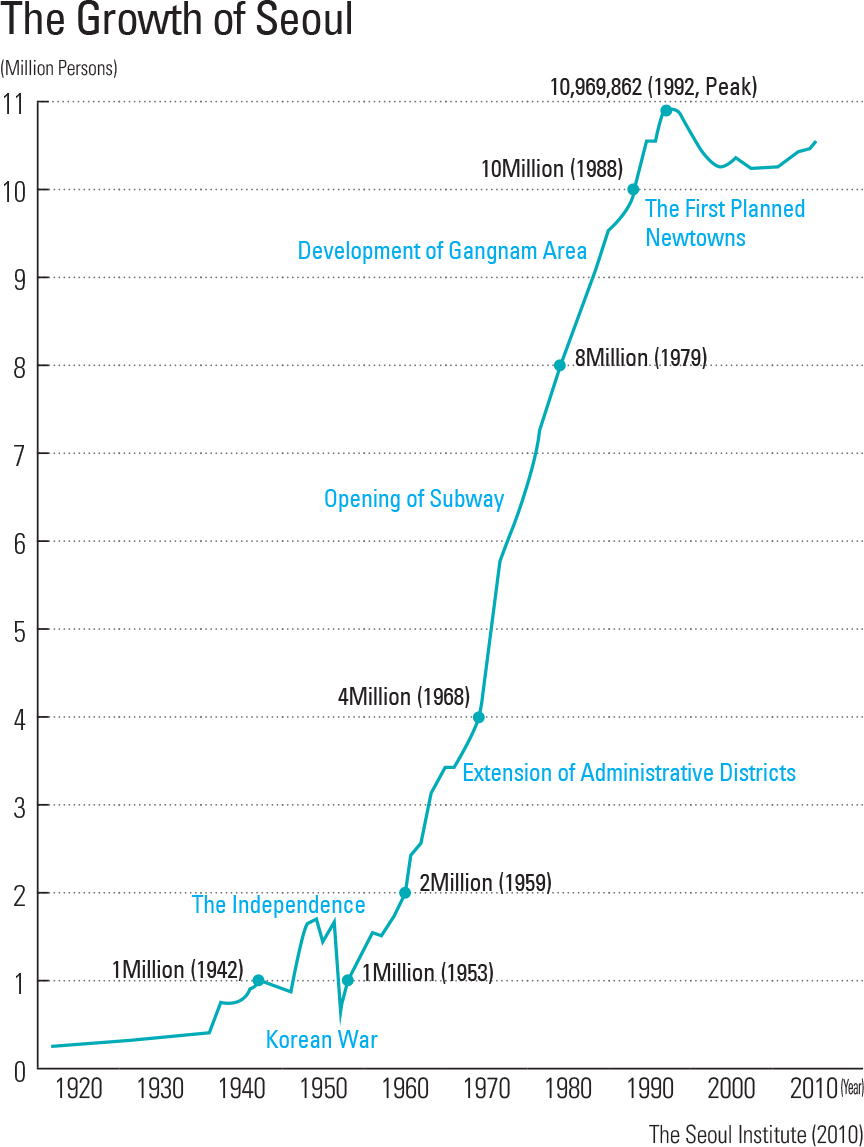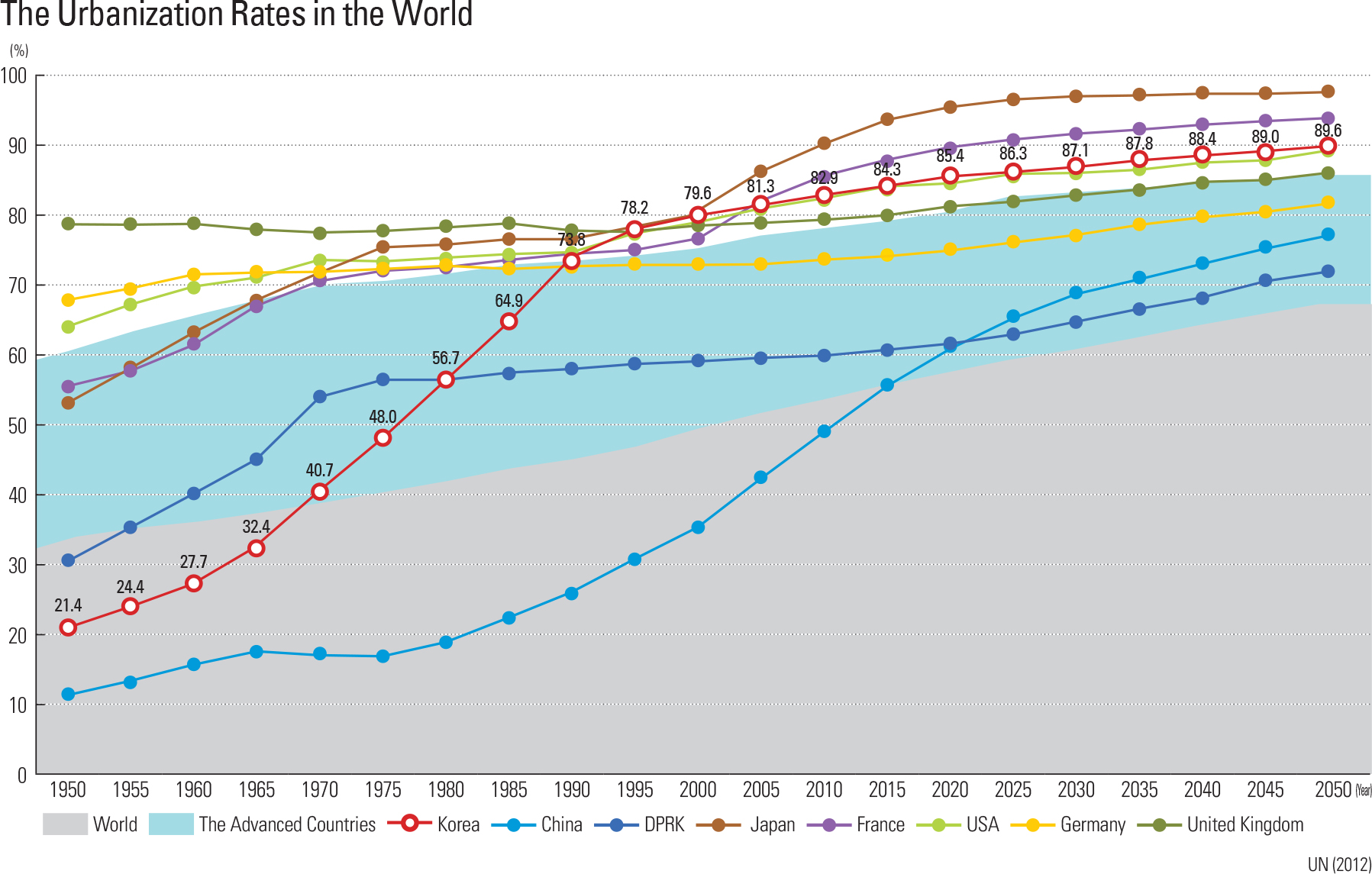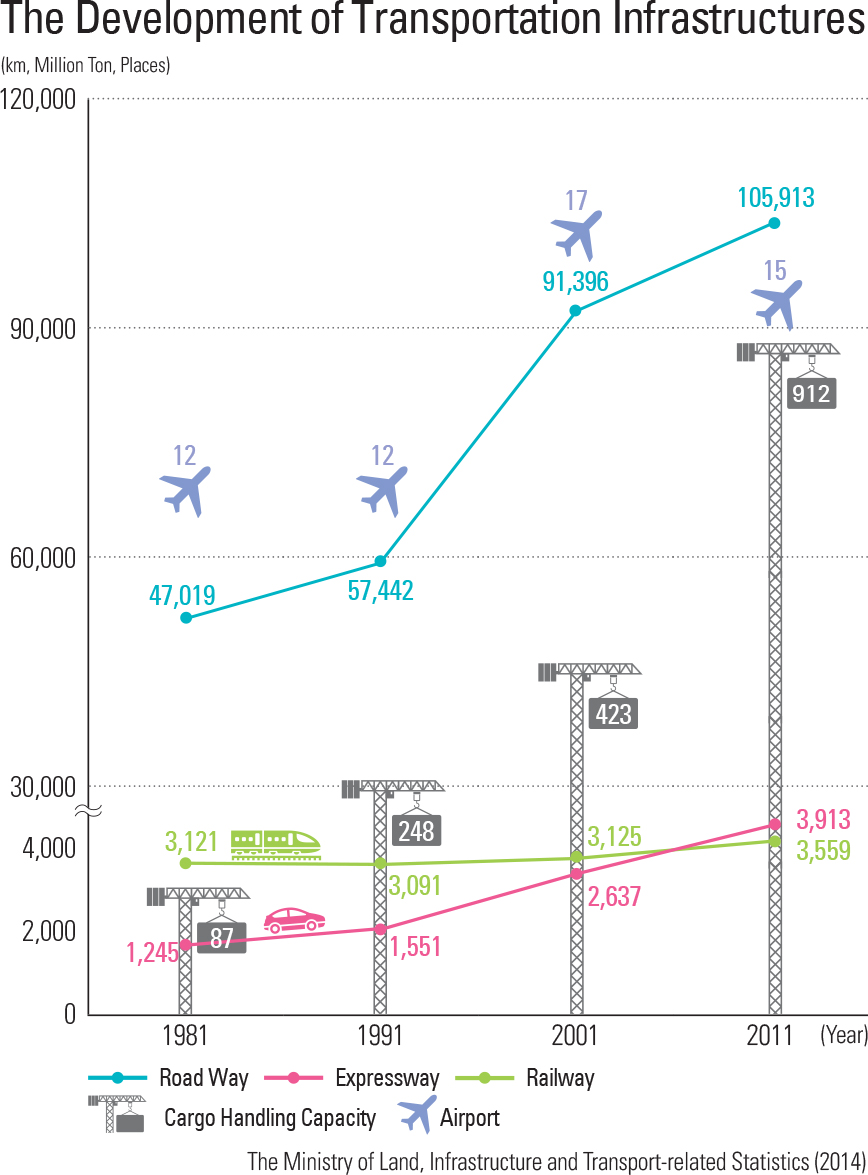Historically, the Korean Peninsula has been called Geumsugangsan, which can best be translated into this poetic phrase: nature appearing as if it were embroidered on silk. Unfortunately, years of Japanese occupation and the subsequent Korean War divided and devastated the country in many ways. The nation’s infrastructure and its industrial capability were destroyed as were numerous residential areas. This devastation led to a shortage of natural resources such as minerals, lumber, oil, and gas, which then triggered a collapse of the national economy, especially in South Korea. Until the early 1960s, Korea was forced to focus on recovering from the devastation of war by utilizing international aid to restore public facilities and rebuild the national economy. For the last 60 years, there have been many changes in the Korean landscape, most of which have stemmed from government-led land development projects, urbanization, and industrialization.
The government’s master plan for land development was put into action in the early 1960s. At that time, the government based its plan on the growth pole theory in order to maximize the development effect in as short a period of time as possible. Though wellintentioned, the growth pole approach only allowed for investment in the few central development areas that were most likely to succeed before development could be considered in other areas. This approach had the unfortunate result of causing both people and capital to flow to those few development centers. The resulting imbalance between those centers and all other areas in the country was later corrected with the implementation of a more balanced set of development policies. Under the Special Area Development Project, Seoul, Incheon, and Ulsan were selected as Special Areas to be developed first on the premise that the effects of such development would gradually enfold the surroundings areas. The Industrial Park Development Project began in Ulsan and Seoul in the early 1960s. Also, during 1960s and 1970s, the Industrial City Construction Project was launched with targeted sites near such industrial parks. This led to the emergence of major chemical industries concentrated in cities such as Ulsan-si, Yeocheon-si, Pohang-si, and Gumi-si with a concordant rise in population in each of these cities.
Urban migration, the nuclearization of families, the increase in national income, and more widespread expectations for a higher quality of life all led to soaring demands for housing in the 1980s and 1990s. The housing supply rose to keep pace with the demand: In 1950, the number of housing units was 3,280,000; by 2011 it had increased five-and-a-half times to 18,130,000. The housing supply rate exceeded 100% by the year 2000. The increase in housing was also a result of many housing-related development policies, such as the Modern Housing Construction Project, the Two Million Housing Construction Project, the Rental Housing Construction Project, and the New Town Development Project. In rural areas, the Saemaeul Project and the Rural Living Environment Program were also implemented.
The transportation sector of the Korean economy rapidly developed as a result of the Export Industry Policy. This was reflected in land spatial structure and regional growth structure that centered on metropolitan areas and the Gyeongbu Axis (Seoul-Busan). Korea’s entry into modern transportation actually began with railways that the Japanese built to invade Korea and seize its resources during the colonial period. In 1955, diesel engine locomotives and a subway system were introduced while double-track railway projects were also promoted. The modernization of rail traffic has been ongoing, and in 2004 the Seoul-Busan High Speed Railway began operation. The development of highways began with the construction of the Gyeongbu Expressway in the 1970s, and since the late 1980s more and more roads have been built and improved as the number of cars has soared and the volume of road traffic has increased. Marine transportation is mainly used for overseas transportation rather than domestic purposes. Major ports of Korea are primarily located along the southeastern coast, which allows for the ready import and export of materials and products needed for chemical industrial plants located in the same region. In 2006, the Busan New Port began operation and has become the center for international marine transportation. Air traffic development began with the construction of airfields built for military purposes during Japanese colonization. Gimpo Airport opened in 1958 and Jeju Airport began operations in 1968. Korea's air transportation has opened a new chapter with the opening of the ultra-modern Incheon International Airport on Yeongjong Island in 2001.
Other major development projects from the 1970s to the present include a number of natural resource and energy related projects such as reforestation, land reclamation, multipurpose dam construction, and nuclear power plant construction.
Urbanization has had major impacts on the country's demographics, its physical landscape, its socialbehavioral institutions, as well as the economy. Symbols that represented cities on the national map kept increasing, and as the number of cities increased, the population of rural areas declined, which also led to a decrease in the percentage of the population that was engaged in agriculture and fishery activities. New cities kept appearing on the national map as larger metropolitan areas continued to expand into rural land surrounding them. The emergence of metropolitan centers is a major feature of development in Korea and resulted primarily from the rural-to-urban migrations, especially in the capital area. After the 1960s, rapid urbanization and industrialization attracted secondary and tertiary industries to cities as well. More jobs were created prompting further mass migrations from rural to urban areas. The urbanization rate, which indicates the ratio of urban population as a percentage of the total population, increased rapidly in Korea until the 1980s, but the pace has slowed since then. Between the 1970s and 1980s urbanization occurred at a much faster rate than in many other countries. As a result, rural areas suffered from the lack of a labor force, a decrease in the coefficient of land utilization, and the rapid aging of its population; these factors ultimately contributed to the failure to meet the minimum requirements for sustaining a rural community in many instances. And at the same time urban areas were confronted with the need to mitigate the challenges of overcrowding. Additionally, the heavy concentration of industrial activity within the metropolitan areas resulted serious social and environmental issues such as housing shortages, traffic congestion, poor air quality, and overall environmental degradation.
There was a clear trend toward excessive expansion in both the capital area and the port cities surrounding the Southeastern Maritime Industrial Region. The expansion between these two regions is related mainly because industrialization took place along the Gyeongbu Axis. Seoul experienced excessive increases in population, but this trend has stalled and decreased since 1990s. The population of nearby satellite cities, however, keeps growing, which results in a population concentration in the greater metropolitan area with Seoul at its center.


